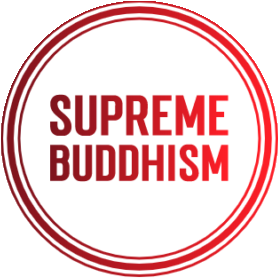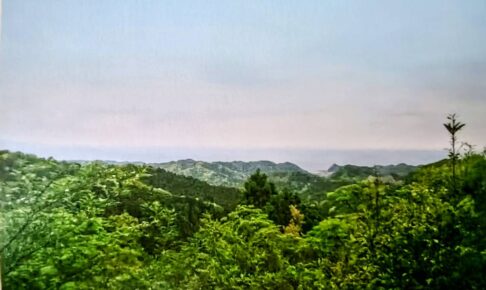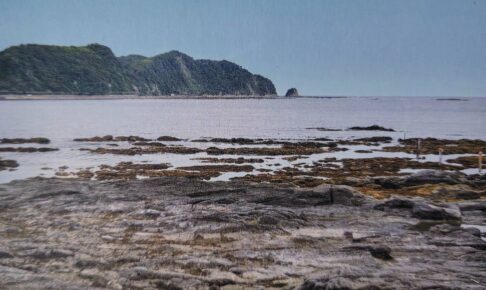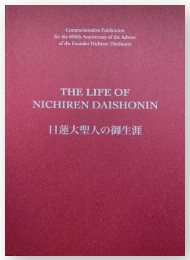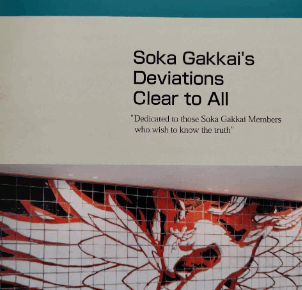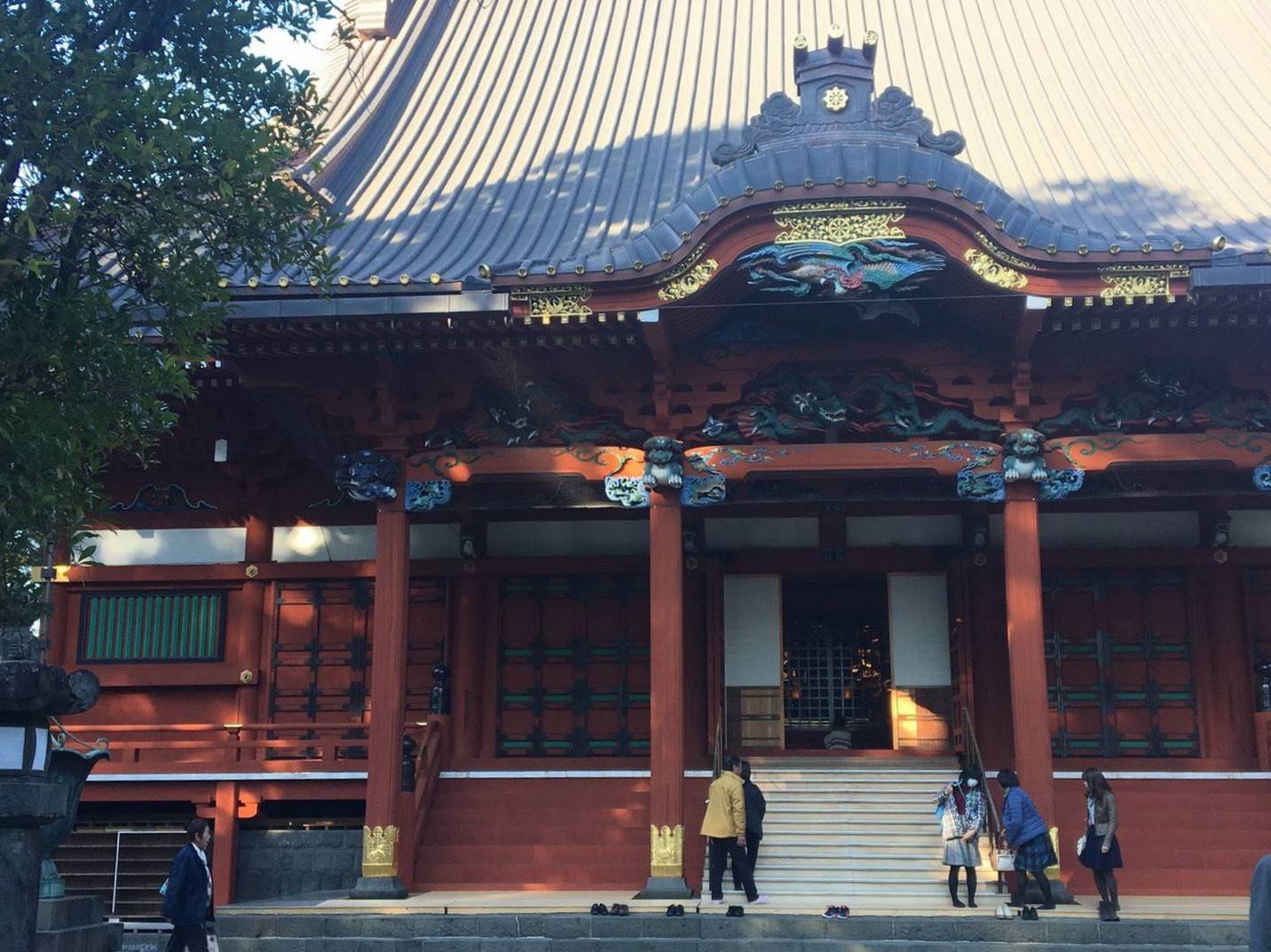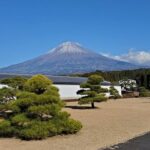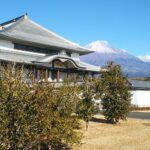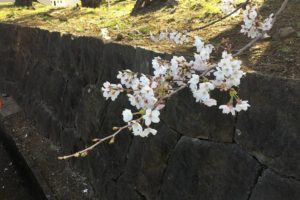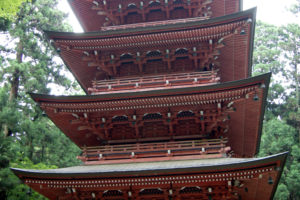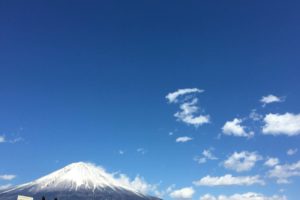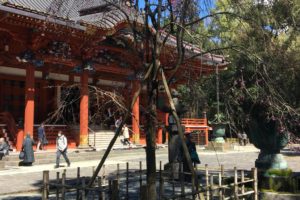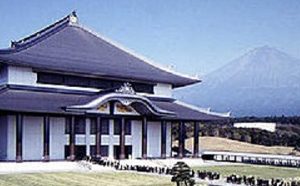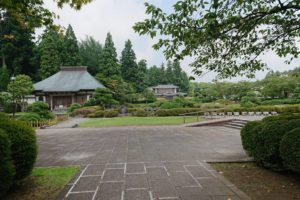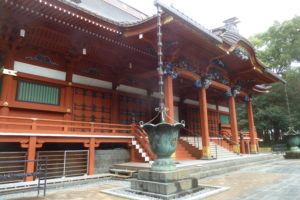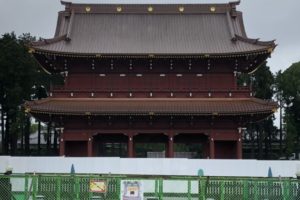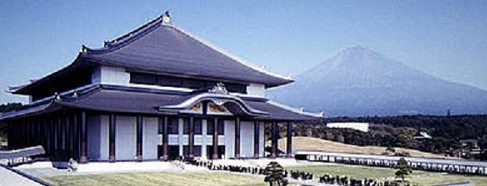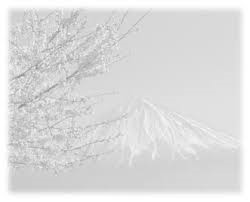This month, my lecture in appreciation to the Daishonin is on the Gosho, “Questions and Answers on the Object of Worship” (Honzon mondo sho). This Gosho was written by Nichiren Daishonin in the ninth month of the first year of Ko’ an (1278), when he was 57 years of age. He sent it from his residence in Minobu to Joken-bo and Gijo-bo at Seichoji Temple.
Joken-bo and Gijo-bo were fellow priests of the Daishonin, when he entered the priesthood at Seichoji Temple under the tutelage of Dozen-bo. Shortly after Nichiren Daishonin declared the establishment of True Buddhism, these two priests became his disciples.
In the second year of Kenji (1276), two years before Nichiren Daishonin wrote this Gosho, “Questions and Answers on the Object of Worship” (Honzon mondo sho), he wrote “Repaying Debts of Gratitude” (Ho’on sho), to express his appreciation for his late teacher. He also addressed this Gosho to Joken-bo and Gijo-bo and instructed them to read it aloud before Dozen-bo’s grave in Kasagamori, where Seichoji was located. Thus, these two priests were extremely familiar with the issues set forth in “Repaying Debts of Gratitude,” but they had some difficult questions. They were unable to understand the following passage: I
First, in Japan and all the other countries throughout the world, the object of worship should in all cases be the Lord Shakyamuni of True Buddhism. The Shakyamuni Buddha and Taho Buddha who appear in the Treasure Tower, as well as all other Buddhas, along with the four bodhisattvas including Jogyo, shall act as attendants to this Buddha.
(Gosho, p. 1036; MW-4, p. 271)
This passage concerns the Object of Worship, the essential significance of Buddhism, and it was completely incomprehensible to those who possessed an immature knowledge of Buddhist doctrine. Joken-bo made inquiries concerning this passage to Nichiren Daishonin. In response, the Daishonin wrote the Gosho, “Questions and Answers on the object of Worship” (Honzon mondo sho). In it he used a question and answer format to expound in detail the significance of the Object of Worship, which is essential to Buddhism. This is the context surrounding the writing of this Gosho.
How, then, should we interpret the passage in “Repaying Debts of Gratitude” that states, “The object of worship should in all cases be the Lord Shakyamuni of True Buddhism”? This passage actually refers to Shakyamuni of the eternal past of kuon-ganjo, who, in fact, is none other than Nichiren Daishonin, the Buddha of Limitless Joy of kuon-ganjo. The rest of the passage explains the Object of Worship in terms of the Person, from the perspective of the Law:
The Shakyamuni Buddha and Taho Buddha who appear in the Treasure Tower, as well as all other Buddhas, along with the four bodhisattvas including Jogyo, shall act as attendants to this Buddha.
Those who were unable to understand that the Daishonin was explaining the Object of Worship in terms of the Person, from the perspective of the Law, were confused by this passage. These words describe the Object of Worship of the great mandala.
If people interpreted the phrase, “the object of worship should in all cases be the Lord Shakyamuni of True Buddhism,” to refer the physical Shakyamuni, then the next phrase, “Shakyamuni Buddha and Taho Buddha who appear in the Treasure Tower…” would give a redundant image of Shakyamuni. This interpretation would lead people who envisioned the establishment of an object of worship into utter confusion about the form in which the object should be created and enshrined.
The phrase, “the object of worship of True Buddhism,” represents the essential subject, and the next phrase, “Shakyamuni Buddha and Taho Buddha who appear in the Treasure Tower…” is explanation of that subject. The first passage presents the Object of Worship in terms of the Person, and the second an explanation of the Object of Worship from the perspective of the Law. We must understand that these phrases together reveal the essential entity of the Object of Worship, the mandala of the Mysteric Law:
Nichiren Daishonin wrote the Gosho, “Questions and Answers on the Object of Worship” and addressed it to Joken-bo and Gijo-bo, who were struggling to understand the significance of the Object of Worship, as it had previously been described in the Gosho, “Repaying Debts of Gratitude.” The Daishonin wrote the following in the opening passage:
Question: As common mortals in the evil world of the Latter Day of the Law, what should we set forth as the object of worship?
Answer: You must establish the Daimoku of the Lotus Sutra as the object of worship.
(Gosho, p. 1274)
Here, the Daishonin presented the Object of Worship based on the Law. This opening passage is the essential subject of this entire Gosho. The remainder of the Gosho is the explanation.
“Questions and Answers on the Object of Worship” consists of thirteen questions and answers. The opening passage indicating the essential subject is the first question-and-answer set. The that follow are the explanation, and this second question-and-answer set and those explanation consists of several different issues. From set two to set seven, the Daishonin expounds the revelation of the Truth (kensho). From set eight to thirteen, he focuses on the refutation of heresy (haja).
The thirteenth question-and-answer set is particularly long. The concluding passage of the answer section reveals the bestowal of the Object of Worship and the benefits thereof. It is the conclusion to the subject presented at the beginning of the Gosho. In this conclusion, Nichiren Daishonin addressed Joken-bo and stated:
I have inscribed the Gohonzon to reveal this, so you must discard all other thoughts. You must face this Gohonzon and single-mindedly focus upon the future. (Gosho, p. 1283)
What is the meaning of the phrase, “I have inscribed the Gohonzon to reveal this”? This passage addresses Joken-bo’ s confusion concerning Shakyamuni as the object of worship as compared to the Object of Worship of the Mystic Law in the form of a mandala. It also attempts to clarify Joken-bo’s doubts, by revealing the relationship between the Lotus Sutra and the Buddha. I will not focus on this aspect today. Since our time is limited, I will primarily concentrate on the essential subject presented in the beginning of the Gosho.
Let us focus on the first question-and-answer set. We will refer to an explanation of this passage by High Priest Nikken Shonin and endeavor to understand its significance.
Question: As common mortals in the evil world of the Latter Day of the Law, what should we set forth as the object of worship?
Answer: You must establish the Daimoku of the Lotus Sutra as the object of worship.
(Gosho, p. 1274)
In a lecture on this Gosho, High Priest Nikken Shonin stated the following:
The Daimoku here refers to none other than Myoho-Renge-Kyo of the Buddhism of the Sowing, from the eternal past of kuon-ganjo. This was set forth in the comparison between the Essential Teaching and Theoretical Teaching of the Lotus Sutra and the comparison between the Buddhism of the Sowing and that of the Harvest. It represents the one and only Dai-Gohonzon of the High Sanctuary of True Buddhism of the Three Great Secret Laws, propagated by the Daishonin, which was based on his actual teaching and was the true purpose of his advent in the Latter Day of the Law. This is the way in which this passage should be interpreted. (Daibyaku-ho No. 647)
Nichiren Daishonin wrote the following in his Gosho, “On the Four Stages of Faith and the Five Stages of Practice” (Shishin gohon sho):
The five characters of Myoho-Renge-Kyo do not represent the sutra text, nor are they its meaning. They are nothing other than the intent of the entire sutra.
(Gosho, p. 1114; MW-6, p. 224)
Here, the Daishonin teaches that there are three aspects concerning the Daimoku and the Lotus Sutra. They are text, meaning, and intent (mon, gi, i).
“Text” (mon) signifies the words of the Buddha. It is the text of the sutras. “Meaning” (gi) indicates the doctrines set forth in the sutras. “Intent” (i) refers to the essential intent of the Buddha.
Specifically, the Daimoku of the text and the Lotus Sutra of the text signify the Daimoku of Myoho-Renge-Kyo that is the title of the entire eight volumes and twenty-eight chapters of the Lotus Sutra. Thus, the Daimoku of the text refers to the surface reading of the text of the Lotus Sutra.
Next, the Daimoku of the meaning and the Lotus Sutra of the meaning are associated with the doctrine in the Juryo (Life Span; sixteenth) chapter of the Essential Teaching, which reveals that Shakyamuni had already attained Buddhahood in the remote past of kuon. This is based on the distinction between the Essential Teaching and the Theoretical Teaching of the Lotus Sutra. The Daimoku of the meaning and the Lotus Sutra of the meaning refer to the process of reading the Lotus Sutra based on this perspective.
Finally, the Daimoku of intent and the Lotus Sutra of intent are none other than Myoho-Renge-Kyo of the Buddhism of the Sowing of the True Cause from the eternal past of kuon-ganjo. It refers to the Daimoku expounded and chanted by Nichiren Daishonin, the True Buddha of kuon-ganjo.
Indeed, Myoho-Renge-Kyo of the Buddhism of the Sowing of the True Cause from the eternal past of kuon-ganjo indicates the one and only Dai-Gohonzon of the High Sanctuary of True Buddhism of the Three Great Secret Laws. It was propagated by Nichiren Daishonin and was based on his actual teaching. It is the true purpose of his advent in the Latter Day of the Law.
Nichiren Daishonin wrote the following in his Gosho, “On the True Cause” (Honnin myo sho):
The practice of Shakyamuni at the Buddha stage at which he first heard the name of the Law (myoji soku) has been transferred to me, Nichiren, at the same stage today, in the Latter Day of the Law.
(Gosho, p. 1684)
Here, he states that Shakyamuni, the True Buddha of the stage at which he first heard the name of the Law (myoji soku) in the eternal past of kuon-ganjo and he, Nichiren Daishonin in the Latter Day of the Law, are entirely identical in their practice and Buddha stage.
Furthermore, Nichiren Daishonin wrote the following in the Gosho, “Reply to Kyo’o” (Kyo’o dono gohenji):
I, Nichiren, have inscribed my life in sumi ink, so believe in the Gohonzon with your whole heart.
(Gosho, p. 685; MW-1, p. 120)
The Daishonin reveals that he inscribed the Dai-Gohonzon of the High Sanctuary of True Buddhism for the sake of the enlightenment of all mankind and for the salvation of all people.
Based on these factors, we can see the profound significance of the first response in “Questions and Answers on the Object
of Worship,” which states, “You must establish the Daimoku of the Lotus Sutra as the object of worship.” This indicates none other than the Dai-Gohonzon of the High Sanctuary of True Buddhism.
When we look upon the Gohonzon inscribed by Nichiren Daishonin, we see that “Nam-Myoho-Renge-Kyo” is written vertically down the center, and immediately below it is the inscription “Nichiren.” This shows that Myoho-Renge-Kyo is the very entity of Nichiren Daishonin. He refers to the Gohonzon of the oneness of the Person and the Law (ninpo ikka) when he states, “You must establish the Daimoku of the Lotus Sutra as the object of worship.” Moreover, in the Gosho, “Repaying Debts of Gratitude,” he declares, “First, in Japan and all the other countries throughout the world, the object of worship should in all cases be the Lord Shakyamuni of True Buddhism.” The Daishonin revealed his life condition by the inscription of “Nam-Myoho-Renge-Kyo, Nichiren.” This manifests the principles of the Person himself the Law (nin soku ho) and the Law is in itself the Person (ho soku nin). Thus this passage describes the essential entity of the object of worship, the mandala the Mystic Law.
Following the first passage of the Gosho, “Questions and Answers on the Object of Worship” (Honzon mondo sho), the second through seventh question and answer sets reveal the Truth. The eighth through the thirteenth sets focus on denouncing slander. Then, in the final passage, which is the conclusion, the Daishonin explains to Joken-bo the bestowal and benefits of the Object of Worship, the mandala of the Mystic Law.
He states:
You must discard all other thoughts. You must face this Gohonzon and single-mindedly focus upon the future.
(Gosho, p. 1283)
He concludes this Gosho by encouraging people to uphold strong faith and to chant Nam-Myoho-Renge-Kyo.
We must realize that it is also our great joy and honor to be able to embrace this truly essential and precious Gohonzon. Nichiren Daishonin wrote the following in the Gosho, “The Entity of the Mystic Law” (Totai gi sho):
Those who c h a n t Nam-Myoho-Renge-Kyo will transform the three paths of earthly desires, karma, and suffering into the three virtues of the Dharma body, wisdom, and emancipation. The threefold contemplation and the three truths will immediately become manifest in their minds, and the place where they live will become the Land of Eternally Tranquil Light.
(Gosho, p. 694; MW-7, p. 64)
Here, the Daishonin teaches that we are capable of transforming all suffering the entirety of our earthly desires, karmic sins from past existences, and karmic hardships – into joy. Furthermore, he teaches that we are capable of establishing a life condition of true happiness. However, this is all based on the power of benefit that is inherent in the Dai-Gohonzon of the High Sanctuary of True Buddhism. No benefit can be achieved if we dissociate ourselves from Nichiren Daishonin’s Gohonzon. We should feel great joy and tremendous pride in the fact that we have been able to embrace the Gohonzon. Let us pledge with one another to exert ever-increasing efforts now and into the future in our practice for ourselves and for others.
